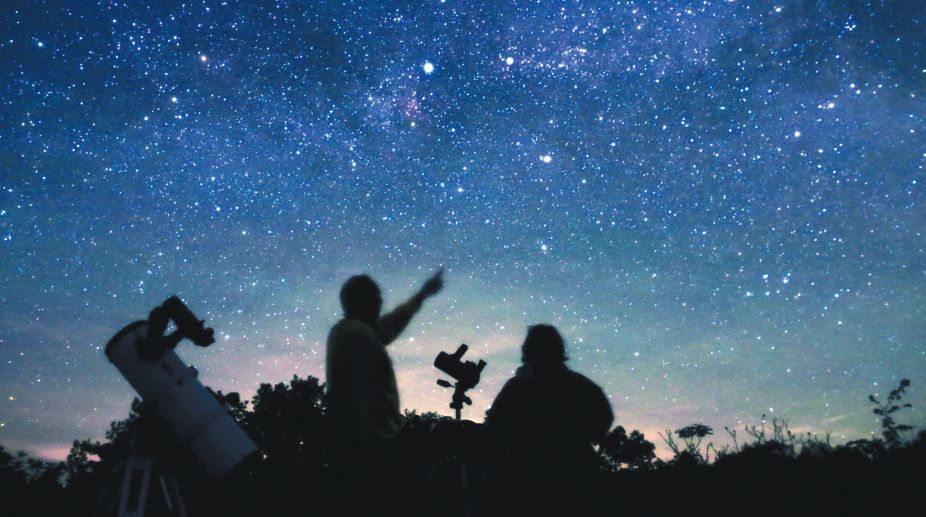Indian-origin astronomer confirms protective shield around dwarf galaxies
Researchers think that a galaxy's corona is a remnant of the primordial cloud of gas that collapsed to form the galaxy billions of years ago.

Representational Image.
One point seven billion is a big number. That’s how many stars have been mapped in the Milky Way, the galaxy that is home to our sun and our solar system.
And if that doesn’t make you feel a bit insignificant, there are hundreds of billions of galaxies in the universe. City dwellers have lost the sense of wonder at the night-time sky as increasingly, urban light pollution blocks our view of our galaxy’s splendid display of distant stars.
Advertisement
Many years ago, I spent a night sleeping in the open at the Pakistan-Iran border, and still remember being awed by the dazzling light show above. It was a reminder of mankind’s insignificance in the scale of things, despite delusions of our importance.
Advertisement
If you visit the website of the European Space Agency’s Gaia mission, you will be able to see the latest images transmitted by the telescope that has been tracking the location, movement and surface temperature of the stars in our galaxy.
At a distance of a million miles, it is free of the Earth’s light, and thus able to send back images of unparalleled clarity. This data has recently been merged into a comprehensive map of the Milky Way that is stunning in its detail.
Recently, scientists confirmed what they had long suspected: Europa, one of Jupiter’s moons, contains more water under its frozen surface than all the water in the Earth’s oceans.
Frequently, it releases plumes of liquid that reach 100 miles (160 kilometres) into space through cracks in the surface. These jets are forced out by the heat at Europa’s core.
This discovery is exciting as water and heat are two of the basic requirements of life. On Earth, geothermal vents at the bottom of the inhospitable seas near the poles are home to tiny creatures that huddle close to these sources of heat. True, they are very basic life-forms, but their very existence surprised scientists.
Europa is even colder, with temperatures that never exceed minus 160 degrees Celsius. Nasa is preparing a mission to investigate further, with a spacecraft that will attempt to fly through a liquid plume to retrieve samples that will be tested on board for signs of biological activity.
Should there actually be indications of life, no matter how basic, it would prove that our planet is not alone in hosting living beings. Arrogantly, some argue that the silence from the stars indicates that we are the only advanced species in our galaxy.
But at the edge of the Milky Way, we would be of little interest to alien worlds. Also, the amount of energy needed to send a radio signal that would retain its coherence over several light years is staggering. Now that thousands of exoplanets — planets circling other stars — have been discovered, it would be foolish to think that only Earth can produce and sustain life.
At the other end of the scale, we have the strange behaviour of sub-atomic particles. Tiny and mysterious, they appear to follow different physical laws entirely. For an example, consider the phenomenon of ‘entanglement’ where one particle of a pair influences the behaviour of its distant partner instantaneously. And scientists have yet to pin down the mysterious ‘dark matter’ that comprises the bulk of the universe.
Many other phenomena relating to gravity, time and space remain unexplained. For those who accept the literal explanation for the beginning of the world transmitted through virtually all faiths, the failure of science to give us a complete ‘theory of everything’ is proof that a supreme being does not wish the ultimate mysteries to be unveiled.
Carlo Rovelli, the Italian physicist, explains the role of science in his book Reality Is Not What It Seems thus:
“Scientific thinking explores and redraws the world, gradually offering us better and better images of it, teaching us to think in ever more effective ways. Science is a continual exploration of ways of thinking. Its strength is its visionary capacity to demolish preconceived ideas, to reveal new regions of reality, and to construct novel and more effective images of the world.…”
This search starts with a basic sense of curiosity and wonder. But if we begin with the premise that all has been explained in ancient texts, then clearly, there is little incentive to explore, test and theorise.
This is the rut that traditional societies are stuck in. Indeed, Prof Abdus Salam’s example is a case study of how backward countries that fear scientific progress deal with their most brilliant minds. Pakistan’s only Nobel laureate in physics was not supported in his quest to establish a research institute in his own country and was forced to leave Islamabad’s Quaid-i-Azam University, where he had been invited to speak, by Jamiat thugs.
This is why no Muslim country has made any significant contribution to scientific progress in recent times. Our failure reflects a lack of curiosity rather than a shortage of resources.
Dawn/ANN.
Advertisement